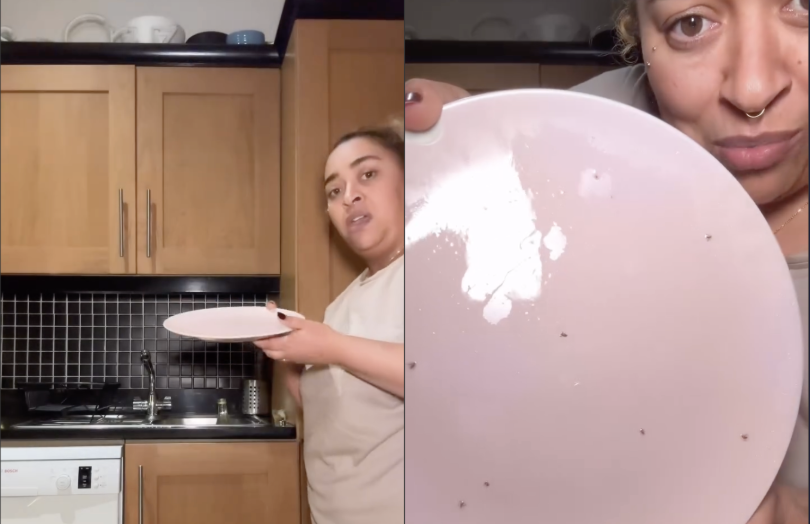
You know that moment when you're trying to enjoy your morning cuppa, and suddenly there's a tiny fly doing laps around your fruit bowl?
Those persistent little buzzers seem to multiply overnight, turning a peaceful kitchen into an aerial battlefield. Well, one clever woman has gone viral with a rather unconventional solution that's got everyone talking—and swatting.
Elaine Cruz's social media trick involves using a plate covered in oil as a fly swatter, allowing you to 'get out some of the frustration' while actually catching the critters.
Her video shows at least half a dozen flies stuck to the oily surface after just a quick swatting session.
'Thank me later but you're welcome. Is it kinda gross? Yeh Does it work? Also yeh,' Cruz captioned her demonstration.
In this article
The viral oil plate phenomenon
The method clearly resonated with frustrated homeowners. One follower enthused: 'OMG! Thank you I do the apple cider vinegar in a jar thing, but it's the ones that jump out of the bin at you that I'm after!!!'
'The little flies are loving your fruit bowl at the moment then. I love this idea except I'll end up throwing the bloody plate!'
While the oil plate method might provide some satisfying revenge against these airborne annoyances, it's worth noting that there's no scientific research backing its effectiveness compared to proven alternatives. It's also worth considering the mess factor—as one commenter noted, you might find yourself binning more plates than flies!
What you're actually dealing with
Before diving into solutions, it's important to understand exactly what's buzzing around your kitchen. What most Australians call 'fruit flies' are actually vinegar flies (Drosophila melanogaster) - small, yellowish flies with distinct red eyes that don't feed on fruit directly, just the yeasts associated with rotting fruit.
These flies are often falsely identified as fruit flies, are about 2-3mm long, tan to pale brown in colour with distinctive red eyes, and while they can be a nuisance, they're not likely to impact undamaged fruit.
Know Your Kitchen Invaders
True fruit flies (Tephritidae family) attack healthy fruit and are agricultural pests
The flies in your kitchen are vinegar flies (Drosophilidae family) attracted to fermentation and rotting matter
Understanding this difference helps you choose the right control method
The science behind the attraction
So why are these tiny creatures so drawn to your kitchen? Vinegar flies are attracted to the smell of fermenting fruit, and since apple cider vinegar is made from fermented apples, its sweet, tangy aroma mimics the scent of rotting fruit exactly what these flies are hunting for.
The key is fermentation—flies have highly sensitive olfactory receptors that detect byproducts of fermentation like acetic acid and ethanol, compounds abundant in apple cider vinegar.
Did you know?
Did you know?
Research published in scientific journals shows that hungry flies behave differently than well-fed ones. When starving, low insulin levels trigger specific neuropeptide systems that make flies attracted to food sources they would normally ignore—explaining why they seem to appear from nowhere when fruit starts to turn!
The tried-and-true champion: apple cider vinegar traps
While the oil plate hack might be satisfying, scientific testing has shown that simple vinegar traps can catch at least 50 fruit flies with minimal effort. Sweet apple cider vinegar is more effective than white vinegar, as fruit flies can't resist the scent of vinegar and won't be able to exit once inside.
Source: @1misscruz / Instagram.
The foolproof method:
The most effective version uses a simple jar with holes punched in the lid. Take a jar and punch a few tiny holes in the lid with a hammer and nail, fill with 1/4 cup of apple cider vinegar and a few drops of liquid dish soap, then leave it out and watch the fruit flies come flocking.
This trap works so well because the scent of apple cider vinegar lures the fruit flies in, and the dish soap changes the surface tension to trap flies when they land in the mix.
DIY Vinegar Trap Success Tips
- Use apple cider vinegar with the 'mother' (cloudy bits) for stronger scent
- Add 2-3 drops of dish soap to break surface tension
- Cover jar with lid punched with small holes (easier than plastic wrap)
- Place multiple traps around problem areas
- Replace every 1-2 weeks for best results
Alternative approaches that work
The vacuum method
Several commenters on Cruz's post mentioned using a vacuum cleaner. One explained: 'I was batting at them at first, but they're so light that my hand was pushing them away. A vacuum sucks them in.'
This method is particularly good for seniors who might have mobility issues with swatting, though it does require getting close to the flies.
Wine bottle traps
Fruit flies love fermented goods like wine and beer, and wine bottles' long necks are perfect for trapping flies, making it difficult for them to escape. Simply leave a bit of wine in the bottom of the bottle with a few drops of dish soap.
Natural deterrents
Basil thrives in most Australian climate zones and produces a scent flies actively avoid—grow it in pots near doorways, windows, and outdoor eating areas, with the added benefit of doubling as a culinary ingredient for kitchen windowsills.
Lavender performs exceptionally well in Australia's drier regions, with its pleasant fragrance repelling flies while attracting beneficial pollinators—plant bushes along pathways or near entertainment areas to create natural fly barriers.
Safety considerations for Australian conditions
Vinegar-based traps are non-toxic and safe to use in kitchens, near pets, and around children, with no chemical fumes making them ideal for daily use.
For the oil plate method, consider these practical points:
- The oil can make surfaces slippery—a particular concern for seniors
- Disposal of oily plates isn't environmentally friendly
- The method requires active swatting, which might not suit everyone's mobility
Prevention: your best defence
Prevention is always better than cure—save yourself the headache of dealing with fly infestations with regular cleaning and good sanitation habits.
Key prevention strategies include:
- Ensure all rubbish bins, waste disposal units, and compost bins have covers that seal shut, and take out trash regularly to prevent flies from flocking to decaying food
- Store ripe fruit in the refrigerator during warmer months
- Clean up spills immediately, especially sugary drinks and fruit juices
- Check screens on doors and windows to ensure there are no holes or tears
Example Scenario
- Managing Cost-Effectively: At around $3-5 for apple cider vinegar that can make multiple traps, compared to commercial fly sprays costing $8-15, DIY methods offer excellent value. One bottle of vinegar can provide months of fly control, making it particularly budget-friendly for pensioners.
When to call in reinforcements
Contact pest control if the infestation is particularly bad or recurring. Pest Control Hub can connect you with professional controllers who specialise in environmentally sensitive approaches, with many professionals now offering integrated pest management combining natural methods with targeted treatments.
The bottom line
While Elaine Cruz's oil plate hack might provide some satisfaction and catch a few flies, the science-backed winner remains the humble apple cider vinegar trap. Multiple users report success with jar traps left on counters for five days managing to rid kitchens of considerable fly populations quickly.
The beauty of vinegar traps lies in their simplicity, safety, and proven effectiveness. Plus, at under a dollar to make, they won't break the budget—and you won't be binning dinner plates in the process.
Whether you choose the viral oil plate method for its therapeutic swatting benefits or stick with tried-and-tested vinegar traps for reliable results, the key is taking action before these tiny invaders take over your kitchen entirely.
What This Means For You
Have you tried any of these methods in your kitchen? We'd love to hear which approach worked best for you—and whether you've discovered any other clever solutions to keep these persistent little buzzers at bay!
Primary Source
https://honey.nine.com.au/living/fr...ate-hack/eb4ae1b1-fcd6-49d8-82f2-fc2d5c06dce9
The Best DIY Fruit Fly Trap for Getting Rid of Fruit Flies
Cited text: The theory is that the vinegar smells irresistibly sweet to the flies, they fly into the traps, and then get their wings weighed down with the dish so...
Excerpt: Elaine Cruz's Instagram hack involves using a plate covered in oil as a fly swatter, allowing you to 'get out some of the frustration' while actually catching the critters
https://www.thekitchn.com/diy-fruit-fly-traps-22942130
The Best DIY Fruit Fly Trap for Getting Rid of Fruit Flies
Cited text: So, I decided to run a semi-scientific test.
Excerpt: Elaine Cruz's Instagram hack involves using a plate covered in oil as a fly swatter, allowing you to 'get out some of the frustration' while actually catching the critters
https://www.thekitchn.com/diy-fruit-fly-traps-22942130
The Best DIY Fruit Fly Trap for Getting Rid of Fruit Flies
Cited text: I set up four different tests, and to my surprise, one method stood out very clearly as the winner.
Excerpt: Elaine Cruz's Instagram hack involves using a plate covered in oil as a fly swatter, allowing you to 'get out some of the frustration' while actually catching the critters
https://www.thekitchn.com/diy-fruit-fly-traps-22942130
Vinegar Fly—The Australian Museum
Cited text: Distribution data sourced from the Atlas of Living Australia · The Vinegar Fly is not actually a fruit fly as it does not feed on fruit directly, just...
Excerpt: What most Australians call 'fruit flies' are actually vinegar flies (Drosophila melanogaster) - small, yellowish flies with distinct red eyes that don't feed on fruit directly, just the yeasts associated with rotting fruit
https://australian.museum/learn/animals/insects/vinegar-fly/
Non-pest species | National Fruit Fly Council
Cited text: Some flies get falsely identified as fruit flies, such as Drosophila melanogaster, also known as ‘vinegar flies’ or ‘ferment flies’.
Excerpt: These flies are often falsely identified as fruit flies, are about 2-3mm long, tan to pale brown in colour with distinctive red eyes, and while they can be a nuisance, they're not likely to impact undamaged fruit
https://www.preventfruitfly.com.au/understanding-fruit-fly/non-pest-species/
Non-pest species | National Fruit Fly Council
Cited text: This fly looks similar but is smaller than the Qfly and Medfly at about 2—3mm long, are tan to pale brown in colour, and have distinctive red eyes.Whi...
Excerpt: These flies are often falsely identified as fruit flies, are about 2-3mm long, tan to pale brown in colour with distinctive red eyes, and while they can be a nuisance, they're not likely to impact undamaged fruit
https://www.preventfruitfly.com.au/understanding-fruit-fly/non-pest-species/
Why Apple Cider Vinegar Is a Must-Have in Any Fruit Fly Trap—wowcatch2025
Cited text: Fruit flies are attracted to the smell of fermenting fruit. Apple cider vinegar (ACV) is made from fermented apples, making it nearly irresistible to ...
Excerpt: Vinegar flies are attracted to the smell of fermenting fruit, and since apple cider vinegar is made from fermented apples, its sweet, tangy aroma mimics the scent of rotting fruit exactly what these flies are hunting for
https://www.wowcatch.com/blogs/news/apple-cider-vinegar-for-fruit-fly-trap
Why Apple Cider Vinegar Is a Must-Have in Any Fruit Fly Trap—wowcatch2025
Cited text: The key is fermentation. Fruit flies have highly sensitive olfactory receptors that detect the byproducts of fermentation like acetic acid and ethanol...
Excerpt: The key is fermentation—flies have highly sensitive olfactory receptors that detect byproducts of fermentation like acetic acid and ethanol, compounds abundant in apple cider vinegar
https://www.wowcatch.com/blogs/news/apple-cider-vinegar-for-fruit-fly-trap
The Best DIY Fruit Fly Trap for Getting Rid of Fruit Flies
Cited text: I caught *at least* 50 fruit flies this way!
Excerpt: scientific testing has shown that simple vinegar traps can catch at least 50 fruit flies
https://www.thekitchn.com/diy-fruit-fly-traps-22942130
The Best Methods for Getting Rid of Fruit Flies Once and for All
Cited text: For this DIY fruit fly trap, sweet apple cider vinegar (ACV) is more effective than white vinegar. Fruit flies can't resist the scent of vinegar,...
Excerpt: Sweet apple cider vinegar is more effective than white vinegar, as fruit flies can't resist the scent of vinegar and won't be able to exit once inside
https://www.goodhousekeeping.com/home/cleaning/tips/a25042/how-to-kill-fruit-flies/
The Best DIY Fruit Fly Trap for Getting Rid of Fruit Flies
Cited text: Read my related post: I Tried (and Failed) to Keep Mosquitoes Away for Years — Then I Found 3 Products That Really Work ... Take a jar and punch a few...
Excerpt: Take a jar and punch a few tiny holes in the lid with a hammer and nail, fill with 1/4 cup of apple cider vinegar and a few drops of liquid dish soap, then leave it out and watch the fruit flies come flocking
https://www.thekitchn.com/diy-fruit-fly-traps-22942130
Best Natural Repellants & DIY Traps for Fruit Fly Prevention
Cited text: This trap works so well because the scent of the apple cider vinegar lures the fruit flies in, and the dish soap changes the surface tension to trap t...
Excerpt: This trap works so well because the scent of apple cider vinegar lures the fruit flies in, and the dish soap changes the surface tension to trap flies when they land in the mix
https://www.arrowexterminators.com/...ow-to-prevent-a-fruit-fly-frenzy-in-your-home
Best Natural Repellants & DIY Traps for Fruit Fly Prevention
Cited text: ... Fruit flies and fermented goods go hand in hand, so it’s no surprise they also love to indulge in wine and beer. It also doesn’t hurt that wine an...
Excerpt: Fruit flies love fermented goods like wine and beer, and wine bottles' long necks are perfect for trapping flies, making it difficult for them to escape
https://www.arrowexterminators.com/...ow-to-prevent-a-fruit-fly-frenzy-in-your-home
What natural fly repellents are effective in Australian conditions? - Pest Control Hub
Cited text: Several plants that thrive in Australian gardens naturally deter flies through their scent or essential oils: Basil thrives in most Australian climate...
Excerpt: Basil thrives in most Australian climate zones and produces a scent flies actively avoid—grow it in pots near doorways, windows, and outdoor eating areas, with the added benefit of doubling as a culinary ingredient for kitchen windowsills
https://pestcontrolhub.com.au/guides/effective-natural-fly-repellents/
What natural fly repellents are effective in Australian conditions? - Pest Control Hub
Cited text: Lavender performs exceptionally well in Australia’s drier regions. Its pleasant fragrance repels flies while attracting beneficial pollinators to your...
Excerpt: Lavender performs exceptionally well in Australia's drier regions, with its pleasant fragrance repelling flies while attracting beneficial pollinators—plant bushes along pathways or near entertainment areas to create natural fly barriers
https://pestcontrolhub.com.au/guides/effective-natural-fly-repellents/
Why Apple Cider Vinegar Is a Must-Have in Any Fruit Fly Trap—wowcatch2025
Cited text: These traps are non-toxic and safe to use in kitchens, near pets, and around kids. Since there are no chemical fumes, they are ideal for daily use. If...
Excerpt: Vinegar-based traps are non-toxic and safe to use in kitchens, near pets, and around children, with no chemical fumes making them ideal for daily use
https://www.wowcatch.com/blogs/news/apple-cider-vinegar-for-fruit-fly-trap
7 Friendly Ways To Get Rid Of Houseflies
Cited text: Prevention is always better than cure. Save yourself the headache of dealing with a fly infestation with regular cleaning and good sanitation habits.
Excerpt: Prevention is always better than cure—save yourself the headache of dealing with fly infestations with regular cleaning and good sanitation habits
https://www.maid2match.com.au/7-friendly-ways-to-get-rid-of-houseflies/
7 Friendly Ways To Get Rid Of Houseflies
Cited text: Ensure all rubbish bins, waste disposal units, and compost bins have covers that fully seal shut. Take out the trash regularly to prevent flies from f...
Excerpt: Ensure all rubbish bins, waste disposal units, and compost bins have covers that seal shut, and take out trash regularly to prevent flies from flocking to decaying food
https://www.maid2match.com.au/7-friendly-ways-to-get-rid-of-houseflies/
7 Friendly Ways To Get Rid Of Houseflies
Cited text: Check on the screens on your doors and windows to ensure there are no holes or seals.
Excerpt: Check screens on doors and windows to ensure there are no holes or tears
https://www.maid2match.com.au/7-friendly-ways-to-get-rid-of-houseflies/
7 Friendly Ways To Get Rid Of Houseflies
Cited text: Contact pest control if the infestation is particularly bad or recurring.
Excerpt: Contact pest control if the infestation is particularly bad or recurring
https://www.maid2match.com.au/7-friendly-ways-to-get-rid-of-houseflies/
What natural fly repellents are effective in Australian conditions? - Pest Control Hub
Cited text: Pest Control Hub can connect you with professional pest controllers who specialise in environmentally sensitive approaches. Many professionals now off...
Excerpt: Pest Control Hub can connect you with professional controllers who specialise in environmentally sensitive approaches, with many professionals now offering integrated pest management combining natural methods with targeted treatments
https://pestcontrolhub.com.au/guides/effective-natural-fly-repellents/
I Tried This DIY Fruit Fly Trap and It’s a Total Game-Changer | The Kitchn
Cited text: I left the jar on the counter for five days, and managed to rid the kitchen of a considerable fruit fly population rather quickly.
Excerpt: Multiple users report success with jar traps left on counters for five days managing to rid kitchens of considerable fly populations quickly
https://www.thekitchn.com/apple-cider-vinegar-diy-fruit-fly-trap-23670359







